Physical Address
Fredericton, New Brunswick, Canada
Physical Address
Fredericton, New Brunswick, Canada
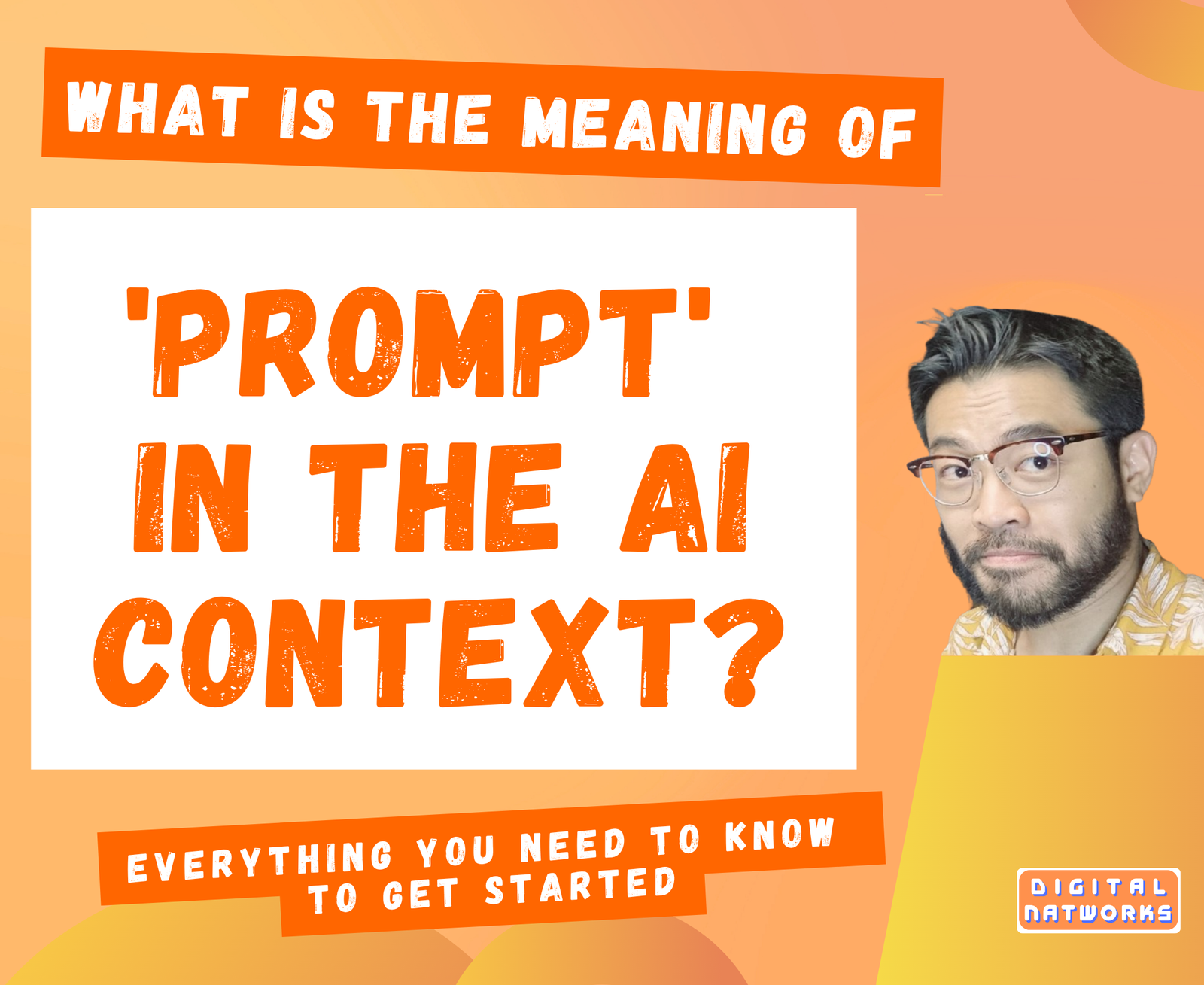
Last updated on October 5th, 2025 at 12:04 pm
The meaning of Prompt (in the AI context) is a conversation starter, a question, or a command that tells AI what you want it to do. An AI prompt is the input or instruction you give to an AI system through Natural Language Processing (NLP) to produce a desired output.
The concept of prompts isn’t entirely new. In traditional programming, developers have always needed to give computers specific instructions. However, AI prompts are different because they use natural language instead of code.
Early AI systems required very technical, structured inputs. Nevertheless, today’s Large Language Models (LLMs) like GPT-4, Claude, and Gemini can understand conversational English, making them accessible to everyone, not just programmers.
AI prompts can be categorized in several ways depending on their purpose, structure, and application. So, I organized AI prompts into 3 main categories:
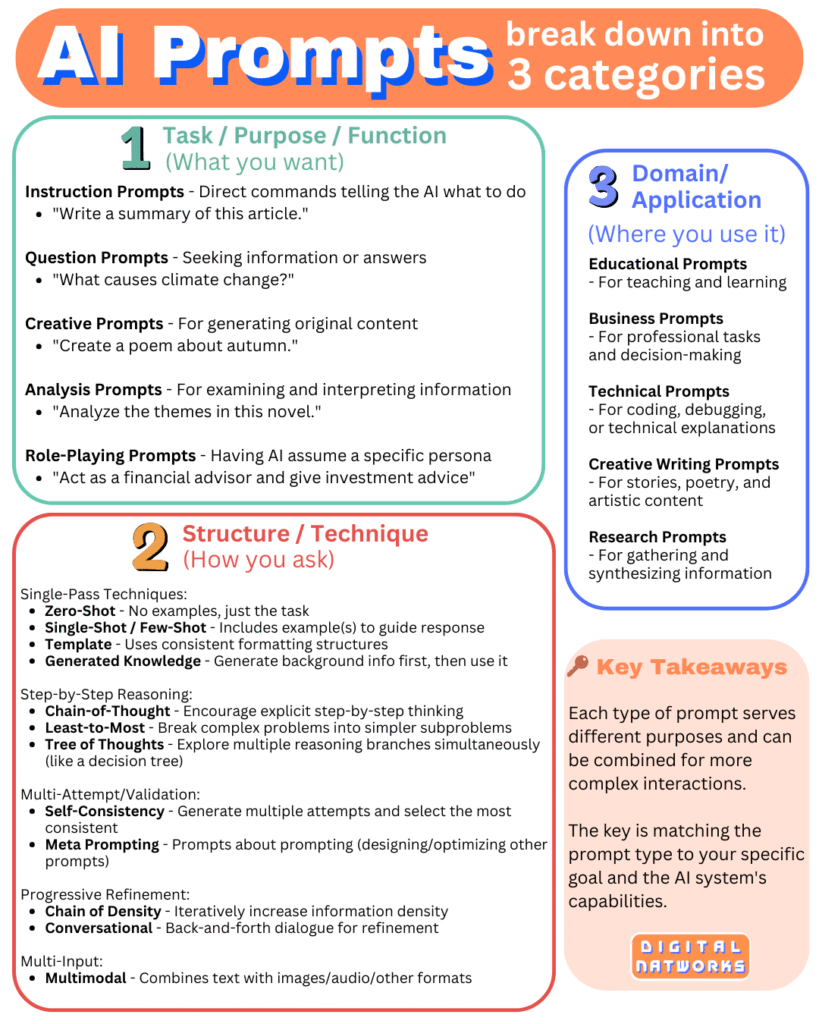
Instruction Prompts – Direct commands telling the AI what to do
Write a summary of this article.Translate this text to Spanish.Question Prompts – Seeking information or answers
What causes climate change?How does photosynthesis work?Creative Prompts – For generating original content
Write a short story about a time traveler.Create a poem about autumn.Here is an example of a creative prompt:
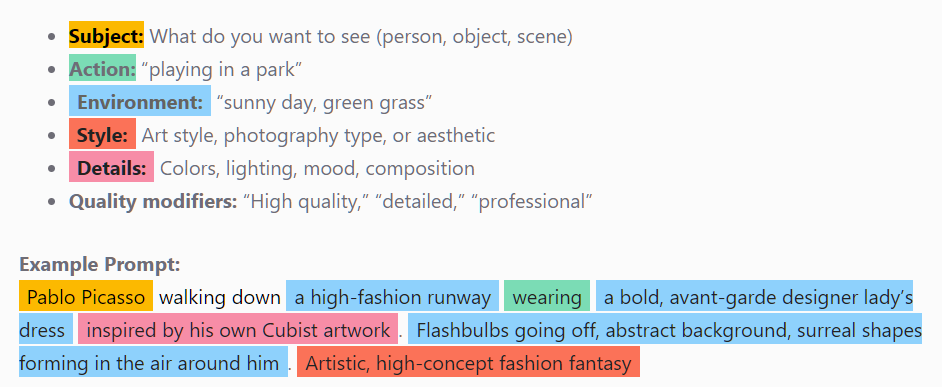
If you want to see an image from this prompt: AI Image Creators: A Complete Guide for Beginners
Analysis Prompts – For examining and interpreting information
Analyze the themes in this novel.What are the pros and cons of remote work?Role-Playing Prompts – Having AI assume a specific persona or perspective
Act as a financial advisor and give investment adviceRespond as a medieval knight wouldSingle-Pass Techniques:
Zero-Shot Prompting – No examples provided, just the task
Classify this email as spam or not spam: [email text]Single-Shot/Few-Shot Prompting – Include examples to guide the response
Here are examples of positive reviews... Now classify this review: [new review]Template Prompting – Use consistent formatting structures
Product: [X], Price: [Y], Write a marketing descriptionGenerated Knowledge Prompting – Generate background info first, then use it
First, list 5 key facts about solar energy. Then use those facts to explain why it's sustainable.Step-by-Step Reasoning:
Chain-of-Thought Prompting – Encourage step-by-step reasoning
Let's work through this math problem step by step.Least-to-Most Prompting – Break complex problems into simpler subproblems
To solve this algebra equation, let's start with the simplest operations first, then tackle the more complex parts.Tree of Thoughts Prompting – Explore multiple reasoning branches simultaneously
Consider three different approaches to solve this business problem: cost-cutting, revenue growth, and market expansion. Evaluate each path.Multi-Attempt / Validation:
Self-Consistency Prompting – Generate multiple attempts and select the most consistent
Solve this logic puzzle three different ways, then compare your answers to find the most reliable solution.Meta Prompting – Prompts about prompting/designing other prompts
What would be the most effective way to prompt an AI to write a compelling product description for a tech startup?Progressive Refinement:
Chain of Density Prompting – Iteratively increase information density.
Write a summary of photosynthesis. Now make it more detailed. Now add technical terminology.Conversational Prompting – Designed for back-and-forth dialogue
Let's discuss the implications of artificial intelligence.Multi-Input:
Multimodal Prompting – Combines text with other formats
Analyze this sales chart [image] and explain what trends you see in the data.Educational Prompts – For teaching and learning
Business Prompts – For professional tasks and decision-making
Technical Prompts – For coding, debugging, or technical explanations
Creative Writing Prompts – For stories, poetry, and artistic content
Research Prompts – For gathering and synthesizing information
Each type serves different purposes and can be combined for more sophisticated interactions. The key is matching the prompt type to your specific goal and the AI system’s capabilities.
Not all prompts are created equal. Want to know how to build a super-effective one?
Let’s break it down by adding one component at a time, following the refined hierarchy: Task, Context, Examples, Constraints, Format, Persona, and Tone & Style.
I’ll walk you through some examples that show how to add each element, step by step.
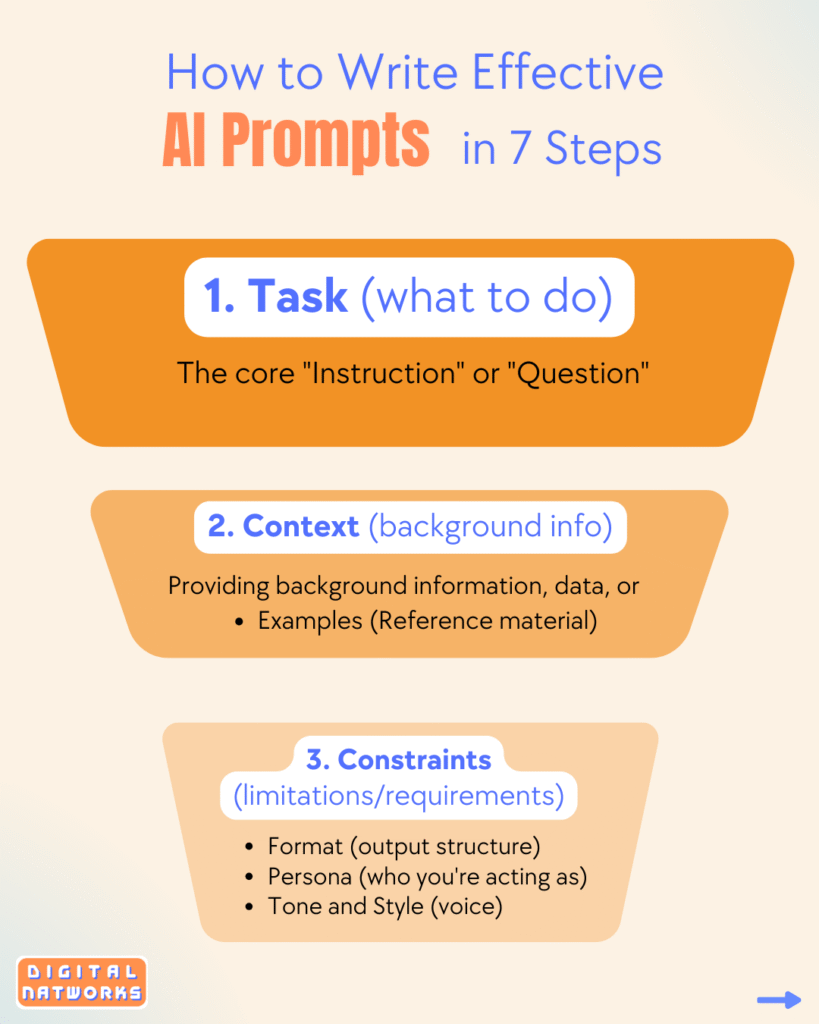
The first thing you need to tell the AI is the task, the core instruction you want the AI to do.
You can either give direct instructions or ask a specific question.
🔑 Nat’s Takeaway:
To give a direct instruction, start with a strong action verb like Write, Summarize, Explain, Compare, Generate, or Extract.
Generate ideas for a marketing campaign for a new product. Step 1: Starting with the Task, I’ll use the word “Generate” for this practical prompt demonstration
Providing background information or data helps the AI understand your situation profoundly, giving you a more accurate and personalized response.
Generate ideas for a marketing campaign for a new product.
The product is a line of eco-friendly sneakers made from recycled materials, targeting young adults aged 18–30 who value sustainability.Step 2: Then, I’ll mention the type of sneaker, material, and the target audience as Context.
When possible, provide Examples (references) of what you’re looking for.
There are 3 types of examples (references):
Generate ideas for a marketing campaign for a new product.
The product is a line of eco-friendly sneakers made from recycled materials, targeting young adults aged 18–30 who value sustainability. For example, include ideas similar to Patagonia's campaigns that emphasize environmental impact, such as videos showcasing the recycling process or partnerships with eco-conscious influencers. Step 3: After that, I’ll give an Example by introducing Patagonia’s ad campaigns.
Constraints are the rules or limitations you give the AI, such as length, format, tone, and content boundaries. This helps the AI give you a more focused, relevant, and structured output.
Generate ideas for a marketing campaign for a new product.
The product is a line of eco-friendly sneakers made from recycled materials, targeting young adults aged 18–30 who value sustainability. For example, include ideas similar to Patagonia's campaigns that emphasize environmental impact, such as videos showcasing the recycling process or partnerships with eco-conscious influencers.
The campaign must fit a budget of $10,000 and focus on digital channels (social media, email, and online ads).Step 4: Next, I’ll lay out some Constraints of a $10,000 budget and digital channels
The desired characteristics of the output, structure, style, and arrangement of your input prompt. You may request a specific format, including a “bulleted list,” a “short email,” or a “table“.
Generate ideas for a marketing campaign for a new product.
The product is a line of eco-friendly sneakers made from recycled materials, targeting young adults aged 18–30 who value sustainability. For example, include ideas similar to Patagonia's campaigns that emphasize environmental impact, such as videos showcasing the recycling process or partnerships with eco-conscious influencers.
The campaign must fit a budget of $10,000 and focus on digital channels (social media, email, and online ads). Present the ideas in a bulleted list with each idea including a brief description and estimated cost.Step 5: At this point, I’ll ask for the Format output to be a bulleted list.
An assigned role or character that influences the AI’s response style, tone, and viewpoint. It’s like asking the AI to put on a costume and act a certain way: a helpful customer service agent, or a professional digital marketer with 10 years of experience, you get an answer that generates more targeted, creative, and relevant outputs for your task. Even create output for a task-specific audience: customer or manager.
Target Audience: Who is the final output for? This is different from the Persona! This is about who the final output is for. Telling the AI your Audience helps it use the right words and level of detail.
For example, you could say: “Act as a digital marketing expert with 5 years of experience in sustainable fashion (Persona) and write a product description for a new line of hiking boots for beginner hikers (Audience).”
Generate ideas for a marketing campaign for a new product.
The product is a line of eco-friendly sneakers made from recycled materials, targeting young adults aged 18–30 who value sustainability. For example, include ideas similar to Patagonia's campaigns that emphasize environmental impact, such as videos showcasing the recycling process or partnerships with eco-conscious influencers.
The campaign must fit a budget of $10,000 and focus on digital channels (social media, email, and online ads). Present the ideas in a bulleted list with each idea including a brief description and estimated cost. Act as a digital marketing expert with 5 years of experience in sustainable fashion.Step 6: Assuming you are a digital marketing expert with 5 years of experience as a Persona.
Tone is all about the emotional or personal attitude you want. Is it casual, serious, or maybe a little humorous? It’s the feeling of the writing.
Style, however, is the specific way the language is put together, like your word choices, sentence length, and overall writing patterns. It’s the blueprint that creates the tone you’re going for.
“Explain quantum physics in a fun, easy-to-understand way for a 12-year-old.”
With additional tone and style, it will yield very different results.
Generate ideas for a marketing campaign for a new product.
The product is a line of eco-friendly sneakers made from recycled materials, targeting young adults aged 18–30 who value sustainability. For example, include ideas similar to Patagonia's campaigns that emphasize environmental impact, such as videos showcasing the recycling process or partnerships with eco-conscious influencers.
The campaign must fit a budget of $10,000 and focus on digital channels (social media, email, and online ads). Present the ideas in a bulleted list with each idea including a brief description and estimated cost. Act as a digital marketing expert with 5 years of experience in sustainable fashion. Use a professional yet enthusiastic tone to appeal to eco-conscious consumers.Step 7: Finally, I use an enthusiastic professional Tone and Style before I hit send.
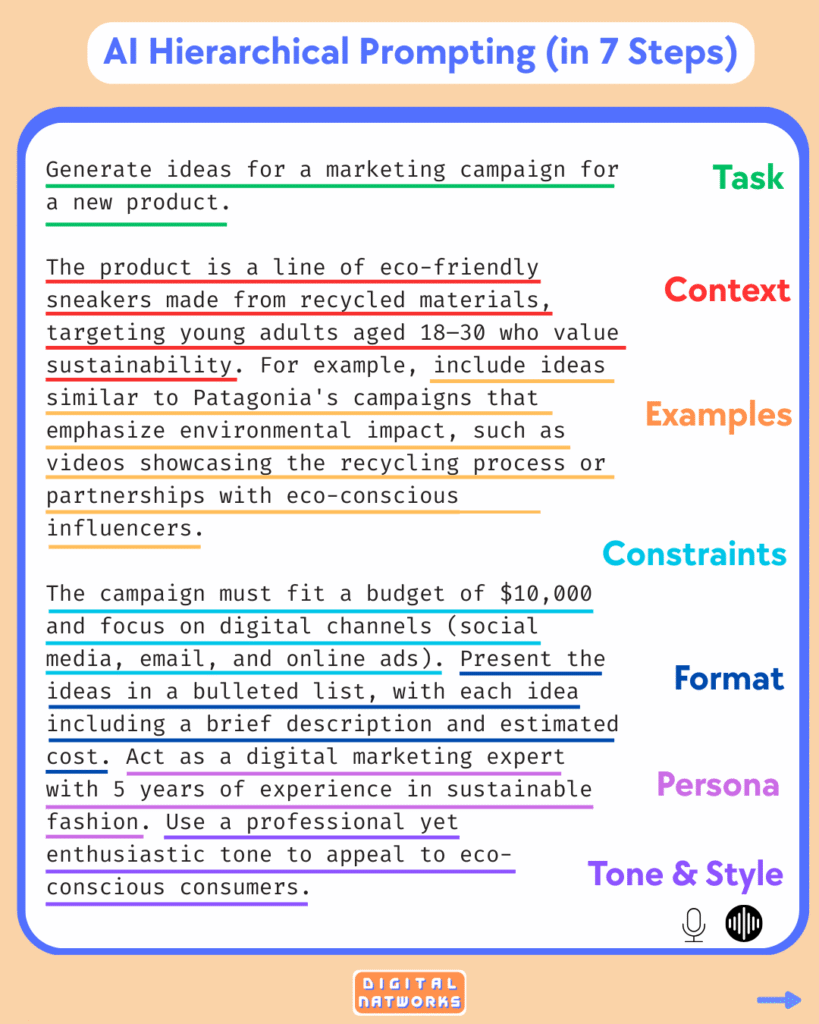
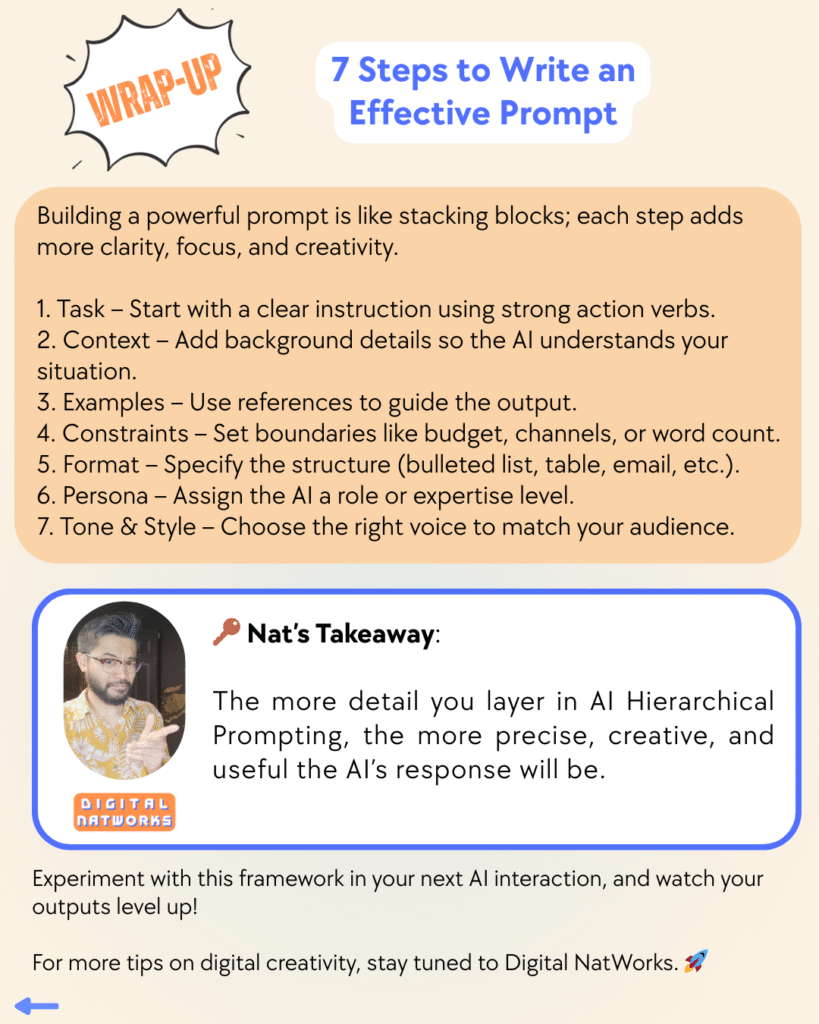
Here are actionable strategies to improve your AI interactions immediately:
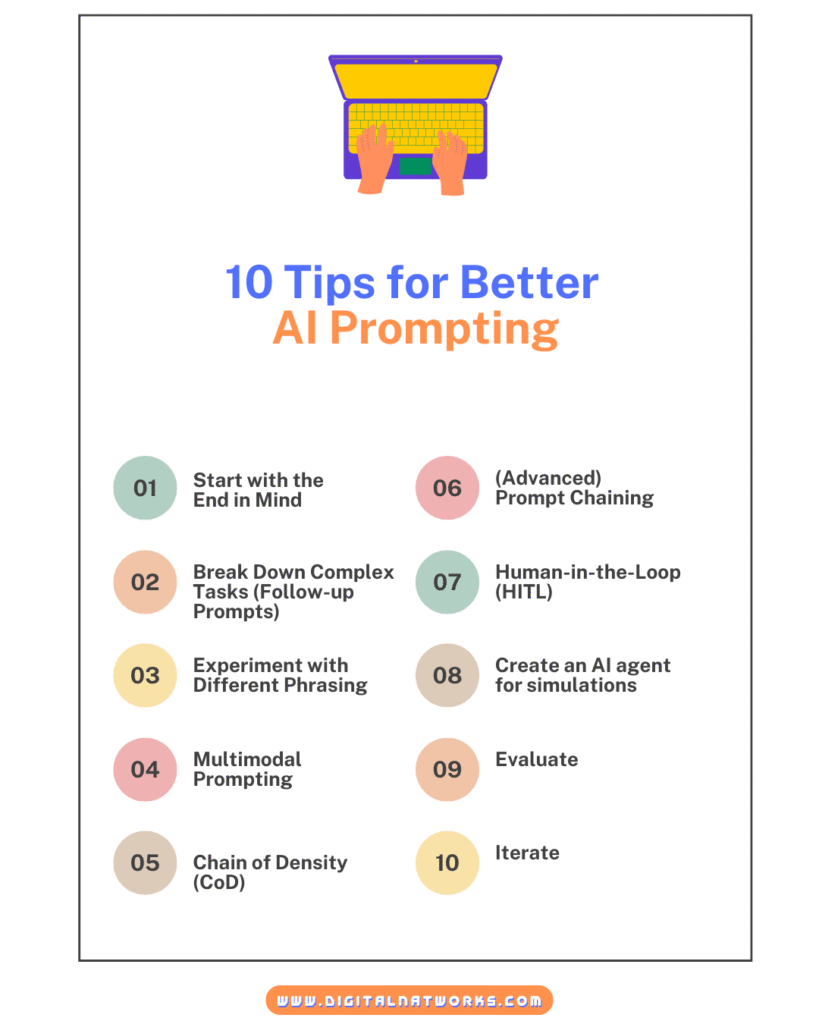
Are you seeking a simple answer, a creative story, or a step-by-step guide?
Before you start typing, ask yourself what you’re trying to achieve. Knowing your goal helps you ask the right questions. You can also tell the AI what persona to adopt, like “You are a financial advisor,” to get a response with the right tone and perspective.
❌ Instead of asking for a complete business plan all at once:
Summarize the key information in this report. Then shorten the key information into bullets, and create visual graphs from the bullets.✅ You can break this up into shorter sentences and input them as separate prompts (Follow-up Prompts):
Summarize the key information in this report.Now, turn that summary into bullet pointsCreate some visual concepts based on those bulletsYou’ll input each prompt and receive output, then follow up with a new prompt until all your tasks have been submitted.
Prompt Chaining is the specific name for using follow-up prompts to break down complex tasks. However, you can use Follow-up Prompts to build on previous responses with follow-up questions.
Instead of asking for a massive project all at once, break it down into smaller, manageable steps. This technique is often called prompt chaining. For example, instead of asking for an entire marketing plan in one go, start with “Summarize the key information in this report,” then follow up with “Now, turn that summary into bullet points,” and finally, “Create some visual concepts based on those bullets.” It’s like building with LEGOs—one piece at a time.
If your first prompt doesn’t work, don’t give up! Try rephrasing it or approaching the topic from a different angle. A slight change in wording can sometimes lead to a much better result.
Don’t just stick to text. Many AI tools let you combine different input types, like images, audio, or video, along with your text. This is called Multimodal Prompting and can give the AI more context to work with.
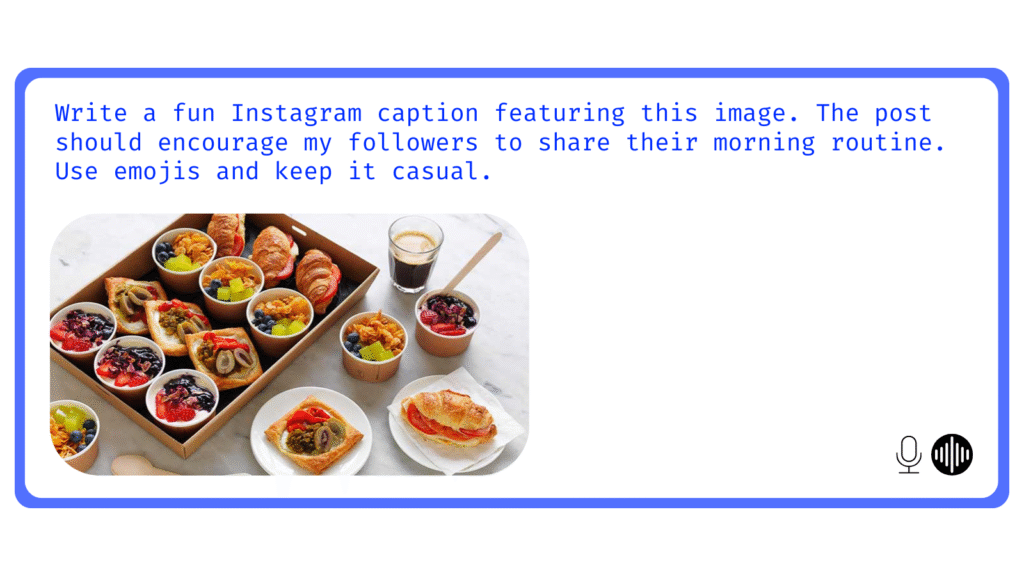
Chain of Density (CoD) is an excellent technique for making summaries. You get increasingly concise summaries and end up with a chain of refined outputs. It’s a way to progressively pack more information into a tight summary without losing essential points.
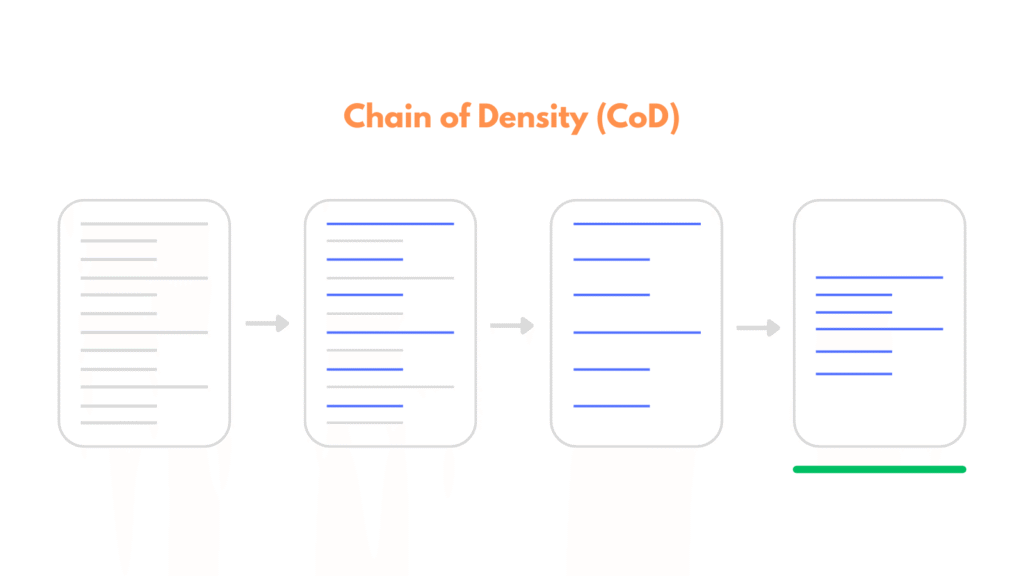
Prompt Chaining isn’t just about breaking down tasks, but it’s about using the AI’s response to build on your following prompt, and so think of it as a puzzle where one piece (the AI’s output) is the key to solving the next part of the problem. This is a powerful way to handle really complex projects.
There are two main types of this advanced chaining:
Chain of Thought (CoT) is where you ask the AI to “think step by step” to show its reasoning. It’s like a math teacher asking students to show their step-by-step calculation. Above all, this is great for making the AI’s process more transparent and helps you spot any mistakes.
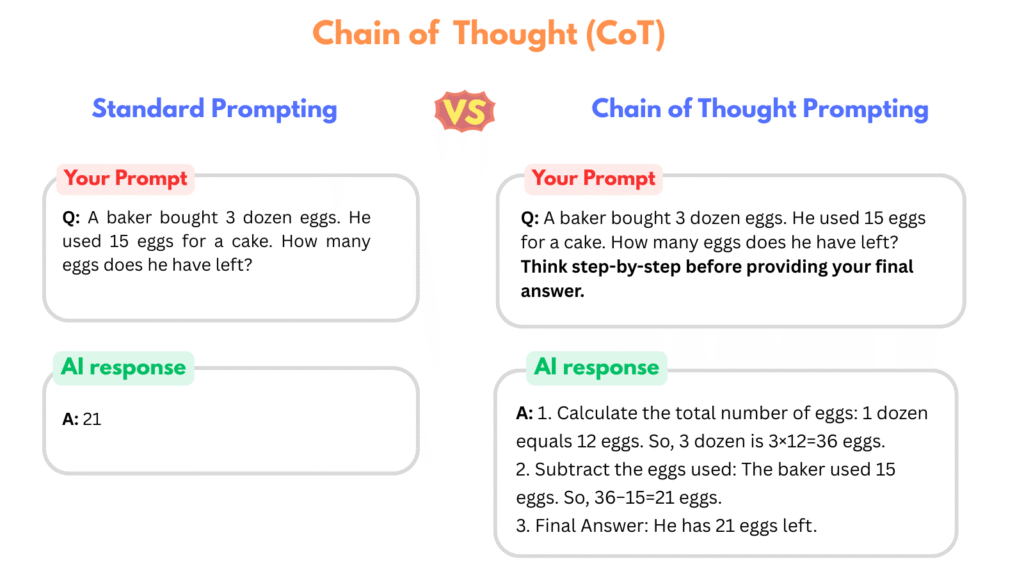
Tree of Thought (ToT) is when a problem has multiple possible solutions. Instead of a single, linear path, the AI explores different “branches” of solutions, and then you can choose the best one. This is perfect for creative or strategic tasks where there isn’t just one correct answer:
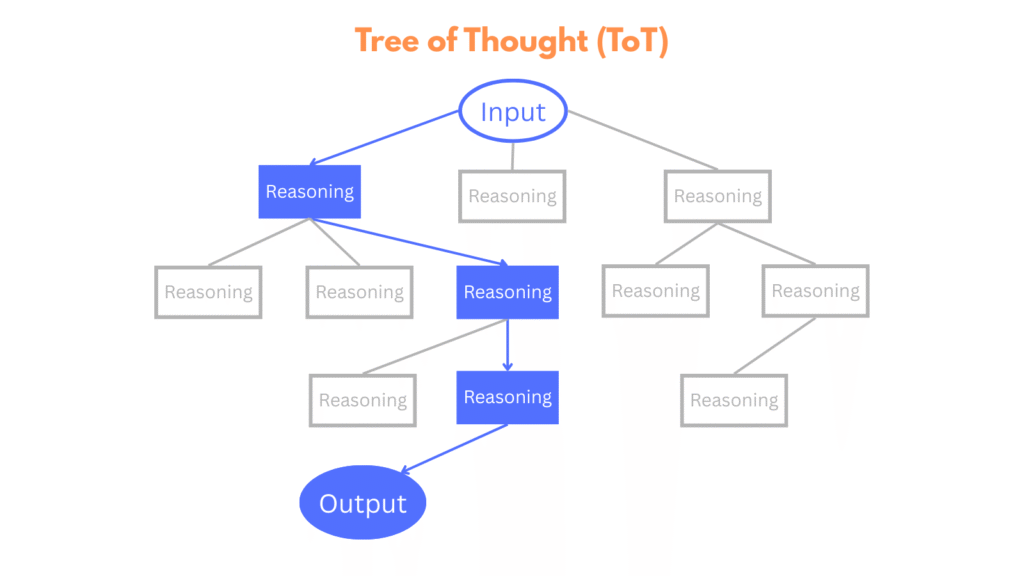
Even with the best prompts, humans need to stay involved. The Human-in-the-Loop approach means you’re checking the AI’s work along the way. This helps you catch any errors or “hallucinations” (where the AI makes things up) and ensures the final output is accurate and ethical.
Can you transform your AI tool into your own team of experts?
Why not? By giving AI a specific persona, you can have it act as a consultant or even be an accountability partner to help you stick to your goals.
The AI Agent helps you simulate scenarios like:
Input you provided = Output you needed?
Make sure the AI’s response is relevant and accurate with your prompt.
Keep evaluating in every step!
If you’re not getting the response that you need?
Either add more information or tweak your prompt.
Your first Prompt might not yield perfect results, and that’s okay.
Iterate to refine, clarify, or expand on the AI’s responses.
Learning what not to do is just as crucial as learning best practices:
When AI generates false or misleading information due to insufficient training data, incorrect model assumptions, or biases in the data.
Biases and stereotypes appear in AI prompts because the large datasets used to train models contain and reflect real-world societal inequalities.
This can lead AI models to produce outputs that are unfair and stereotypical, such as depicting CEOs primarily as white men or associating certain racial groups with negative outcomes.
These biases can stem from biased data collection, algorithmic design, and human biases in prompt design, creating a feedback loop that perpetuates and amplifies existing prejudices.
To mitigate this, developers and users must employ strategies like inclusive prompt engineering, diversifying training datasets, and conducting bias audits to ensure more equitable and accurate AI outputs.
While context is essential, dumping too much information in one prompt can confuse the AI.
So, try to break complex requests into smaller or Follow-up Prompts
AI systems have knowledge cutoffs and limitations. Always verify important information, especially for recent events or specialized technical details.
Understanding how different industries use prompts can inspire your own applications:
Writers and marketers (including myself 😂) use prompts for blog ideas, social media content, product descriptions, and email campaigns. The key is being specific about the target audience, tone, and objectives.
Teachers create lesson plans, quiz questions, and explanations tailored to different learning levels. This is an example of educational content about AI design. On the flip side, students use prompts for research assistance, essay brainstorming, and concept clarification.
Professionals use prompts for market research, competitive analysis, SWOT assessments, and strategic planning. AI can quickly synthesize information and provide structured insights.
Programmers use prompts for code generation, debugging assistance, documentation writing, and explaining complex technical concepts to non-technical stakeholders.
As AI technology evolves, prompting is becoming more sophisticated. We’re seeing developments in multimodal prompts (combining text, images, and audio), prompt chaining for complex workflows, and AI systems that can better understand context and intent with minimal input.
However, the fundamental principles of clear communication, specificity, and iterative refinement will remain important regardless of technological advances.
Ready to start experimenting? Here are some beginner-friendly prompts to try:
For learning: “Explain [topic] in simple terms, using analogies where helpful”
For problem-solving: “I’m facing [specific problem]. What are three different approaches I could take?”
Creativity purpose: “Generate five unique ideas for [specific creative project or challenge]”
For productivity: “Create a daily routine that includes [specific activities/goals]”
For analysis: “What are the main advantages and disadvantages of [specific option/decision]?”
Understanding prompts is your gateway to unlocking the full potential of AI tools. Remember that effective prompting is a skill that improves with practice. Start with clear, specific instructions, don’t be afraid to iterate and refine your approach, and always keep your end goal in mind.
As AI becomes increasingly integrated into our daily work and personal lives, those who master the art of prompting will have a significant advantage. Doesn’t matter who you are, a student, professional, creative, or entrepreneur, learning to communicate effectively with AI systems is an investment in your future productivity and success.
The key takeaway? Great prompts lead to great results. Start practicing now, and you’ll quickly discover just how powerful these AI tools can be when you know how to ask the right questions correctly.
Ready to dive deeper into AI and digital innovation? Explore more insights and practical guides at digitalnatworks.com, where I break down complex technology topics into actionable knowledge for you.

(Nat) Natthapoom Saenghan founded Digital NatWorks, a platform dedicated to helping creators, entrepreneurs, and digital marketers harness the power of AI design and automation tools.
With an MBA from University Canada West and a Bachelor of Fine Arts from Silpakorn University, he combines over 17 years of artistic experience with marketing and tech skills to simplify digital solutions for beginners and pros alike.
Passionate about creative technology, Nat aims to make AI tools accessible, practical, and profitable through expert guides, honest reviews, and affiliate resources.